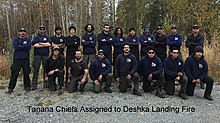Tanana Chiefs Conference
The Tanana Chiefs Conference is a non-profit organization with a membership of Native governments from 42 Interior Alaska communities.
In 2006, The Tanana Chiefs Conference had almost seven hundred full-time employees and numerous part-time and seasonal positions.
The history of the Tanana Chiefs Conference (TCC) reflects the importance of balancing the traditional Native values with the modern demands facing us as indigenous peoples.
The Alaska Statehood Act recognized Native land rights, yet the state administration began planning as though it did not.
That project and another ill-conceived idea - creating a harbor at Point Hope on the Northwest coast with nuclear blast - contributed substantially to the rise of the land claims movement.
A remarkable array of young, educated Native leaders began pushing the land claims toward a suitable outcome.
Ketzler left TCC from 1964 until 1969 to go back to Nenana, but other young leaders - Ralph Purdue, John Sackett and Tim Wallis - took over.
The act created the regional corporations for the management of land and financial assets, and overseeing the development of natural resources.
Village corporations, representing individual Native communities, have their own natural and financial resources to maintain.
TCC incorporated Doyon Limited as the regional for-profit corporation for the specific purpose of making a profit for their stockholders.
The act left a place for non-profit corporations to administer health and social service programs for the people.
During the 1980s, this process allowed for more local employment, attention to subregional program priorities, and better access by TCC clients to information and services.

